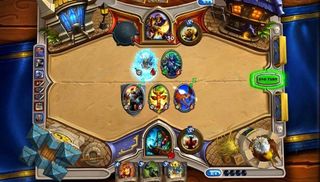As Sherlock Holmes says, take advantage of your powers of deduction
A 30 card deck is smaller than most CCG players are used to. This means it's often fairly easy to deduce what is in your opponent's deck — especially since there really aren't a great deal of cards in play at the moment.
Use the knowledge you have (what class they're playing, how much mana crystals they have, how many cards in hand, what cards have been played so far) to deduce what they might play on their next few turns, and prepare accordingly.
Learn what each class's single target removal spells and sweeper abilities are and plan accordingly. This might mean baiting a Polymorph or Assassinate with a moderately large guy before playing a bomb, or maybe holding back a creature or two if your opponent is in sweeper rage.
Remember who you're up against. Playing a 2/1 on turn 1 is a bad move versus Mage, as they can easily ping it with their Hero ability. Versus Hunter or Warlock, though, the same play isn't so bad.

Making favorable trades is key to victory
Hearthstone is all about board control and tempo, especially since you can't play cards during your opponent's turn.
Build your deck so that you know what your ideal first turn cards should be, and mulligan aggressively if those cards aren't in your hand. If you're playing first, then that's a 1 - 2 - 3 mana curve. Playing second (ie, with the coin) then it's 2 - 2 - 3. This varies depending on some hero powers (namely Pally and Shaman where the 2 drop is less important, since their ability gets them a piece on the board).
Learn when to trade and when to swing at your opponent's face. In general, the cost of the card(s) used to remove an enemy minion should be equal or less than the cost of the removed minion. In other words, you shouldn't swing a 2-cost 3/2 into a 1-cost 2/1. But a 1-cost 2/1 and a 2-cost 3/2 for a 4-cost 4/5 is a good trade.
The biggest gaming news, reviews and hardware deals
Keep up to date with the most important stories and the best deals, as picked by the PC Gamer team.
Having said that, unless the only way is via a bad trade, it's usually best to target your opponent's creatures before their hero . In general, it is better for you to dictate the terms of the trade than your opponent. The active player always has the advantage by choosing the most favorable trades and being able to affect things via spells or battlecry effects. Take out your opponent's minions while you have the power.
Mentally adjust the value of your minions as they are buffed and receive damage, and take this into account when calculating trades.
With over two decades covering videogames, Tim has been there from the beginning. In his case, that meant playing Elite in 'co-op' on a BBC Micro (one player uses the movement keys, the other shoots) until his parents finally caved and bought an Amstrad CPC 6128. These days, when not steering the good ship PC Gamer, Tim spends his time complaining that all Priest mains in Hearthstone are degenerates and raiding in Destiny 2. He's almost certainly doing one of these right now.
Most Popular






